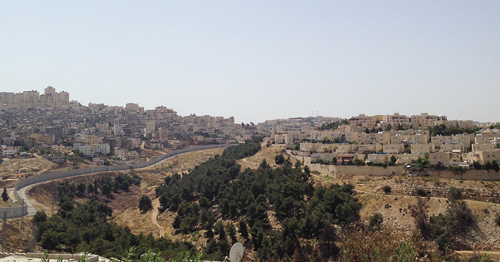
Since the mid-twentieth century, Israel has worked to gradually erase Palestinian existence and identity. The Nakba of 1948 and Israel’s continued dispossession of Palestinians within the first few decades of the state’s establishment provided a clear example of what more would come. Accordingly, the occupation of the West Bank, including East Jerusalem, and the Gaza Strip in 1967 – recognized as the Occupied Palestinian Territory (OPT) under international law – was merely a continuation of what Israel began in 1948: the erasure of Palestine in order to establish a settler-colonial state.
Indeed, over the past 50 years of occupation, we have seen the constant takeover of Palestinian land, the continued displacement of Palestinians, and the persistent rewriting of the Palestinian narrative.
After beginning the occupation in 1967, Israel introduced a comprehensive legal system to justify the illegal confiscation of Palestinian land in the OPT. This system was articulated through Israeli military orders, which altered legislation that existed prior to the occupation, in violation of international law and Israel’s duties as Occupying Power.i They include orders on the various methods of land acquisition, such as the requisition of land for military needs, the confiscation of absentee property,ii and declarations of “state” land; and orders that establish a discriminatory permit and planning system for Palestinians.
Immediately following 1967, Israel appropriated 730,214 dunums (10 dunums = 1 hectare) out of a total of 6 million dunums in the West Bank.iii
These were lands either registered to Jordaniv or belonging to Palestinian landowners whom Israel classified as “absentees.”v Simultaneously, Israel issued numerous military orders to requisition thousands of dunums of private Palestinian property for alleged military needs; such lands were used to establish some 40 settlements.vi
This practice, however, drastically decreased in 1979, when the Israeli High Court ruled in the Elon Moreh case that it was illegal for the state to build permanent settlements on private Palestinian property that was requisitioned for military needs.vii However, the judgment was narrow in that it did not end the practice of confiscating land for purported military needs: it in fact continued at such a rate that by 1984, nearly 1.11 million dunums of land had been confiscated in this manner.viii
In order to adapt and continue colonizing the West Bank, Israel instituted an active policyix of “state land” declarations that mainly targeted unregistered land. Although surveys showed that the majority of land in the West Bank was privately owned, little of it was registered.x This was in part due to the fact that Israel ended land registration (also by military order) in 1968,xi making the lands more susceptible to Israeli confiscation. Over the years, Israel has declared over 750,000 dunums of property in the West Bank to be state land.xii
When the Oslo Accords were signed, approximately 655,000 dunums of these declared state lands were designated as part of Area C.xiii Area C amounts to nearly 60 percent of the West Bank, holds the majority of Palestinian natural resources, and is under full Israeli control. While Oslo provided a pretense of a path to independence, it only consolidated Israeli control over Palestinian land. Similarly, as other empty negotiations begin and end, settlements expand and bolder policies arise to displace Palestinians. This is exemplified in the February 2017 “regularization law” passed by the Knesset, which retroactively legalizes the (illegal) expropriation of private Palestinian land in the West Bank.

Alongside the taking of land through “legal” and administrative systems, the establishment of the Annexation Wall has served to further embed Israeli settlements and related occupation policies. The Wall’s construction was widely condemned by the international community, and the International Court of Justice (ICJ) confirmed the illegality of the Wall and its associated regime in an advisory opinion in 2004. Irrespective of the ICJ opinion, which affirmed “It is for all States…to see to it that any impediment, resulting from the construction of the wall, to the exercise by the Palestinian people of its right to self-determination is brought to an end,” no concrete action has been taken since. Instead, this June marks the 15th anniversary of the beginning of Israel’s building of the Wall.
The impact of the Wall on fragmenting Palestinian communities and serving the Israeli settlement agenda is exemplified in occupied East Jerusalem. There, the Wall’s path captured Israeli settlements such as Ma’ale Adumim and extra land for settlement growth as it excluded densely populated Palestinian areas. The Wall, coupled with the Israeli permit system, also effectively cut off Jerusalem, the historical economic, cultural, and religious center, from the majority of Palestinians in the OPT.
It is important to underscore that while East Jerusalem is a part of the West Bank, Israel illegally annexed the city in 1967, extending its municipal boundaries and applying Israeli civil laws to the territory. In 1980, Israel took steps to reaffirm its annexation with the passage of the “Basic Law” on Jerusalem, which states, “Jerusalem, complete and united, is the capital of Israel.” The international community has not recognized Israel’s annexation of East Jerusalem, and it remains occupied territory.
Furthermore, since 1967, Israel has implemented an array of policies that target Palestinian residents of Jerusalem, with the ultimate goal of removing them and Judaizing the city. Whether through land confiscation, a discriminatory permit and planning system – which only allocates 13 percent of the land for Palestinian development – inadequate infrastructure, the active revocation of residency and property rights, or countless other measures, Israel creates an environment that aims to force the Palestinian population to leave, while encouraging the increase of Israeli settlements.
It should, therefore, go without saying that Israel’s control over land and the practices it imposes, ranging from access restrictions to home demolitions, have a grave impact on the individual and collective rights of Palestinians. The UN Security Council recently reiterated, “all measures aimed at altering the demographic composition, character and status” of the OPT, including East Jerusalem, were “in violation of international humanitarian law and relevant resolutions.” The resolution (2334/2016) went on to reaffirm that Israeli settlements have “no legal validity.”
Irrespective of endless condemnations and the clear violations of international law which Israeli policies and practices entail, settlements persist and grow. More settlers are brought to the OPT to create “facts on the ground.” More profits are derived from control over Area C, where Israeli industrial and agricultural settlements proliferate (at the expense of the Palestinian economy).
And, more subtly, settlements and land use, including the mere presence of over 600,000 settlers, are used to obscure reality. If tourists drive through the Jordan Valley, they find Israeli flags and signs for settlements perched along the road. Average tourists or pilgrims would be unable to determine whether they were in the OPT or Israel, or that the well-manicured settlements are illegal. Similarly, it is unlikely that tourists are aware of being in Palestine when they are in occupied East Jerusalem, or why settlement tourist sites such as the City of David and others based on creative storytelling are problematic.
In total, Israel’s control over land enables it to create unsustainable living conditions for Palestinians in the OPT, while also appropriating the narrative in an attempt to legitimize its presence and to a greater extent, its oppressive 50-year occupation.
» Marya Farah and Aseil Abu-Baker are both awyers who focus on international law.
i. These military orders amended Ottoman and British Mandate laws that were subsumed into the Jordanian legal system that governed the West Bank prior to the Israeli occupation in 1967. See R. Shehadeh, Occupier’s Law: Israel and the West Bank, Institute for Palestine Studies, Washington, DC, 1985, p. 23.
ii. Military Order Number 58 (July 23, 1967) concerning Absentee Property (Private Property). Pursuant to this order, the Custodian of Absentee Property of the Israeli Civil Administration would safeguard the property until the owner returned, at which time he/she could successfully reclaim ownership. Israel made this nearly impossible, by, for example, not allowing landowners to return to the West Bank, specifically those from the Jordan Valley. See A. Eldar, “Ministry admits ‘blacklist’ of Palestinians who left the West Bank during Six-Day war,” Haaretz (July 5, 2006), http://www.haaretz.com/print-edition/news/ministry-admits-blacklist-of-palestinians-who-left-west-bank-during-six-day-war-1.192233.
iii. G. Bisharat, “Land, Law, and Legitimacy in Israel and the Occupied Territories,” American University Law Review, 43, no. 2, pp. 467–561 (1994), fn. 334.
iv. This was the first iteration of what Israel defined as “state property.” Military order number 50 of July 31, 1967, defined state property as any property, which prior to June 7, 1967, was owned by a “hostile” state or any arbitration body of that state, in this case, Jordan.
v. Defined as those who left the region “on or before the appointed date (June 7, 1967) or subsequently thereto.” Military Order Number 58 (July 23, 1967) concerning absentee property (private property). This worked similar to the absentee property law that appropriated Palestinian land in 1948.
vi. Kerem Navot, A Locked Garden, Declaration of Closed Areas in the West Bank, March 2015, p. 26.
vii. “Seventeen Residents of the Village of Rujeib,” The Government of Israel et al, HCJ 390/79, October 22, 1979. After this ruling, the state reduced but did not end the use of confiscation based on military needs for the establishment of new settlements, but continued to expand and build settlements on land that had been confiscated on this basis prior to the ruling.
viii. G.Bisharat, “Land, Law, and Legitimacy in Israel and the Occupied Territories,” American University Law Review, 43, no. 2, (1994), p. 534.
ix. Government Decision Number 145, November 11, 1979. While there had been set definitions under the Ottoman Code of what constituted state land, Israel, through various military orders, altered the defintions to allow property that had not been considered state land to be deemed government property under speciific conditions.
x. R.Shehadeh, The Law of the Land, Settlements and Land Issues Under Israeli Military Occupation, Palestinian Academic Society for the Study of International Affairs-Passia, Jerusalem, 1993, p. 20.
xi.Military Order No. 291(1968) Regarding the Arrangement of Land and Water, section 3.
xii.Kerem Navot, Blue and White Make Black: The Work of the Blue Line Team in the West Bank, December 2016, p. 42.
xiii.Ibid.


